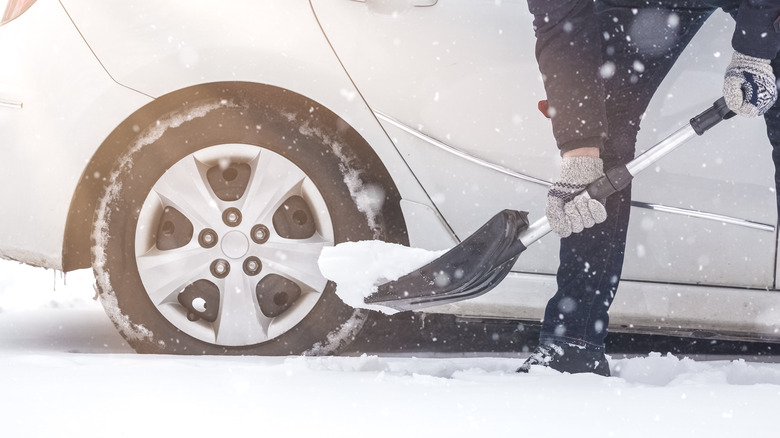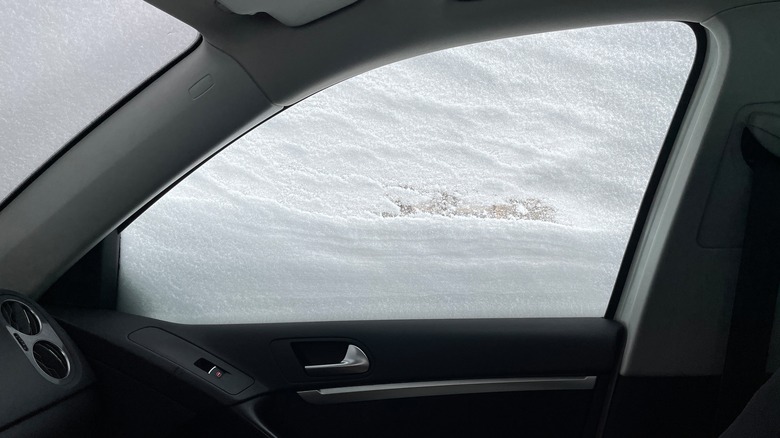How A Swedish Man Survived In His Car For Two Months In A 2011 Snowstorm
It's human nature to wonder: If any one of us were trapped in a disaster situation, how would we survive? In 2011, a massive snow storm blanketed Sweden, especially an area near the town of Umeå, based on BBC News reporting. Amid heavy snowfall, a local man was trapped inside his car. Two months later, he was rescued, and though badly weakened by the ordeal, he survived. How is it possible that a human being lasted for eight weeks with no food and only water from melted snow to keep himself hydrated, as temperatures reportedly reached as low as -22 degrees Fahrenheit, with some reports stating they dropped as low as -30, according to the Daily Mail?
After prolonged exposure, in a matter of minutes, temperatures that cold can kill a poorly-prepared individual trapped more or less outdoors without adequate shelter (via Live Science). As it turns out, that lucky Swedish man in 2011 who survived two months in his car likely survived because he was inadvertently protected by a fundamental survival technique — a recommended plan of action for anyone who finds themselves faced with survival outdoors in snow and freezing temperatures, as The Guardian explains.
He was trapped in his car with a sleeping bag
Peter Skyllberg, the Swedish man who reportedly survived two months in his car in Arctic temperatures, per Daily Mail, was not entirely without resources when he found himself unable to move, his vehicle submerged in a snowdrift. He had a sleeping bag, and he had some shelter, in the form of his car. As The Guardian goes on to note, Skyllberg, in his mid-40s at the time of the incident, was discovered by snowshoers. After digging through roughly three feet of snow, they found him huddled in his sleeping bag in the front seat of his vehicle. He could barely move or speak.
Could Skyllberg have fallen into some kind of state of hibernation like a bear, an uncommon occurrence for a human being? That's likely not the case, according to Noorland's University Hospital chief medical officer, Dr Ulf Segerberg, speaking with The Guardian. Segerberg said, "[Humans] can't lower body temperature very much. A little bit we can, but if we lower body temperatures more than just a little bit, we lose consciousness and go into a coma." The possibility that Segerberg somehow did reach a state of hibernation, however, could not be ruled out.
Skyllberg likely survived thanks to the 'igloo effect'
Among the many challenges Skyllberg faced in his predicament, lack of food was the least of his worries. According to Healthline, human beings can only survive about a week with no food or water, but in Skyllberg's case, he found some hydration in melted snow. With water alone, humans can survive as long as three months. But what about the freezing temperatures? He did have a sleeping bag, which probably helped but more than anything, as Skyllberg outlasted the trial thanks to the so-called igloo effect, created by Skyllberg's car.
The igloo effect, the same explanation for how some indigenous northern cultures survive in ice and snow structures, traps heat, and is also the rationale behind building or digging a shelter out of ice and snow, should one find themselves trapped outdoors in inclement weather, according to Gear Patrol. As Dr. Segerberg went on to note (The Sydney Morning Herald), "'Igloos usually have a temperature of a couple of degrees below zero and if you have good clothes you would survive in those temperatures and be able to preserve your body temperature.” Still, Skyllberg was rescued at the very last minute and may not have survived much longer. He was treated at a local Swedish hospital and reportedly recovered from the terrible experience (per The Guardian).


